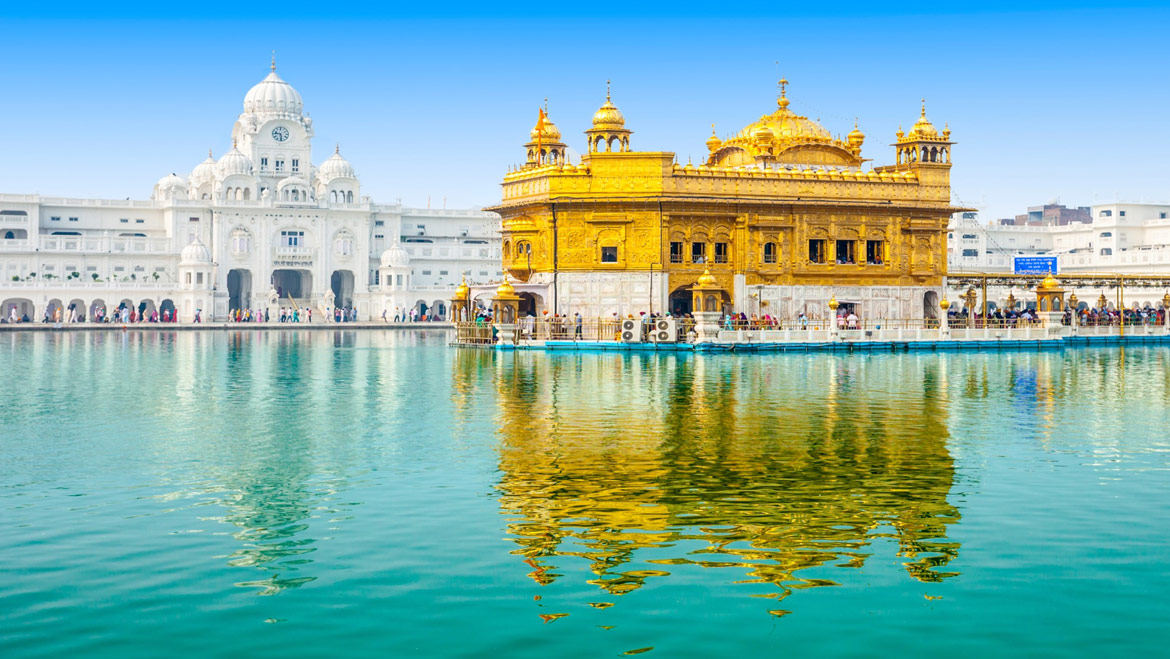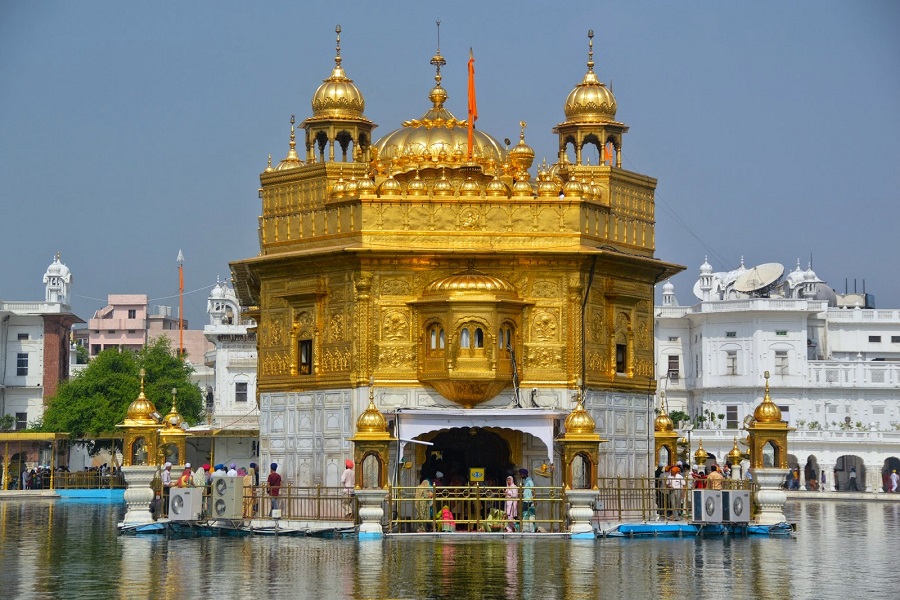Punjab is home to stunning Gurudwaras. These sacred places reflect deep spirituality and rich history.
Exploring Gurudwaras in Punjab offers a unique cultural experience. Each Gurudwara tells a different story of faith and tradition. The architecture is breathtaking, showcasing intricate designs and serene surroundings. Visiting these holy sites allows you to connect with the essence of Sikhism.
You can witness daily rituals and join prayers that bring peace and harmony. The hospitality at each Gurudwara is heartwarming, making visitors feel welcome and respected. Additionally, the community kitchens, known as Langars, offer delicious food to all visitors, symbolizing equality and compassion. Embarking on a Gurudwara tour in Punjab is not just a trip; it’s a journey of the soul, enriching your mind and spirit.
Introduction To Punjab’s Gurudwaras
Punjab, the land of five rivers, holds a special place in the heart of every Sikh. Renowned for its vibrant culture, delicious cuisine, and warm-hearted people, Punjab is also home to some of the most revered Gurudwaras in the world. These sacred sites attract millions of devotees and tourists from around the globe, offering a glimpse into the rich spiritual and historical tapestry of Sikhism. Let’s delve into the captivating world of Punjab’s Gurudwaras.
Historical Significance
Many of Punjab’s Gurudwaras are steeped in history, holding stories that date back centuries. For instance, the Golden Temple in Amritsar, also known as Harmandir Sahib, was founded in 1577 by the fourth Sikh Guru, Guru Ram Das. It is not only a place of worship but also a symbol of the Sikh struggle and resilience. You can feel the weight of history as you walk around its sacred waters.
Another noteworthy Gurudwara is Anandpur Sahib, where Guru Gobind Singh founded the Khalsa in 1699. This event marked a turning point in Sikh history, emphasizing the values of bravery and equality. Imagine standing in the very place where these significant events unfolded – it’s a humbling experience.
Spiritual Importance
Visiting a Gurudwara in Punjab is not just about sightseeing; it’s a spiritual journey. These places offer a serene environment where you can find peace and solace. The rhythmic chants of Gurbani, the communal Langar (free kitchen), and the aura of devotion create a unique atmosphere that touches your soul.
Take the Golden Temple, for example. Sitting by the Amrit Sarovar (holy tank) at dawn, watching the temple’s golden façade reflecting in the water, you can’t help but feel a profound sense of tranquility. It’s a moment that stays with you long after you leave.
Have you ever wondered why people from different faiths visit Gurudwaras? It’s because these places embody universal values of love, compassion, and equality. The open doors of a Gurudwara welcome everyone, breaking down barriers of caste, creed, and religion.
When you plan your Gurudwara tour in Punjab, you’re not just exploring historical sites; you’re embarking on a spiritual quest. Whether you seek solace, strength, or simply a deeper understanding of Sikhism, Punjab’s Gurudwaras offer an enriching experience that resonates on a deeply personal level.
So, are you ready to immerse yourself in the spiritual and historical essence of Punjab? The sacred journey awaits you.
Harmandir Sahib
When you think about a Gurudwara tour in Punjab, the Harmandir Sahib, also known as the Golden Temple, is a must-visit. This iconic site in Amritsar is not just a place of worship but a symbol of peace, spirituality, and the rich heritage of the Sikh community. Visiting the Harmandir Sahib is an experience that stays with you long after you leave.
Golden Temple
As you approach the Harmandir Sahib, your eyes are instantly drawn to the Golden Temple at its heart. Covered in over 750 kg of pure gold, the temple glistens brilliantly under the sun. The serene Amrit Sarovar (holy tank) surrounding the temple adds to its splendor, creating mesmerizing reflections that make you pause and appreciate the beauty.
Walking through the temple complex, you’ll see devotees from all walks of life, united in their faith. One of the most humbling experiences is the community kitchen, or Langar, where thousands are fed daily. The sense of community and selfless service here is truly inspiring.
Architectural Marvel
The Harmandir Sahib is not just a spiritual haven; it’s an architectural masterpiece. The blend of Islamic and Hindu architectural styles is evident in its intricate designs and motifs. The temple’s lower level is made of white marble, while the upper level shines with gold leaf, symbolizing the union of the earthly and the divine.
As you explore the temple, you’ll notice the detailed frescoes, inlaid marble work, and the stunning gold dome. The Guru Granth Sahib, the holy scripture of Sikhism, is housed in the inner sanctum, adding a profound layer of spirituality to the architectural grandeur.
Have you ever wondered what makes a place like this so special? It’s not just the gold or the architecture. It’s the history, the people, and the feeling of belonging that you get as soon as you step in. It makes you reflect on your own spirituality and the values you hold dear.
Next time you plan a trip to Punjab, make sure to include the Harmandir Sahib in your itinerary. Whether you’re seeking peace, inspiration, or simply a glimpse into the rich Sikh heritage, this place offers it all.
Takht Sri Damdama Sahib
Takht Sri Damdama Sahib is one of the five temporal seats of Sikhism. Located in the serene village of Talwandi Sabo, it holds immense spiritual significance. Guru Gobind Singh, the tenth Sikh Guru, stayed here in 1705. He compiled the final edition of the Guru Granth Sahib at this sacred site.
Historical Events
Takht Sri Damdama Sahib witnessed many pivotal events in Sikh history. Guru Gobind Singh spent nine months here. During his stay, he prepared the Sikhs for the future. This period was filled with teaching and guidance. The Guru also baptized many followers here. These events cemented the site’s importance in Sikh history.
Spiritual Retreat
The Gurudwara provides a serene retreat for visitors. The peaceful environment offers a perfect place for meditation and reflection. Many come here to connect with their spirituality. The tranquil surroundings enhance the experience. Devotees often find solace and inner peace. The sacred atmosphere helps in spiritual growth and understanding.

Credit: www.tourmyindia.com
Anandpur Sahib
Anandpur Sahib, a key destination in the Gurudwara Tour of Punjab, is rich in Sikh history and culture. Known for its stunning architecture, it attracts pilgrims and tourists alike.
Anandpur Sahib, a picturesque city in Punjab, is known for its profound spiritual significance and rich history. Nestled in the foothills of the Shivalik range, this sacred town is one of the holiest places for Sikhs. Anandpur Sahib is not just a place of worship; it is a symbol of valor, faith, and the indomitable spirit of the Sikh community. If you are planning a Gurudwara tour in Punjab, Anandpur Sahib should undoubtedly be on your list.Birthplace Of Khalsa
Stepping into Anandpur Sahib, you can feel the reverence in the air. This divine city is renowned as the birthplace of Khalsa, a significant event in Sikh history. On the auspicious day of Vaisakhi in 1699, Guru Gobind Singh Ji, the tenth Sikh Guru, founded the Khalsa Panth. This transformative moment is commemorated at the Takht Sri Keshgarh Sahib, one of the five temporal thrones of Sikhism. When you visit, you can stand in the very place where Guru Gobind Singh Ji initiated the five beloved ones, known as the Panj Pyare. It’s a moment of reflection and connection, where you can almost hear the echoes of the past. The historical artifacts and weapons displayed here offer a glimpse into the valor and sacrifice of the Sikh warriors. Have you ever wondered what it must have felt like to be a part of such a pivotal moment in history?Festivals And Celebrations
Anandpur Sahib comes alive with vibrant colors and festivities, especially during the Baisakhi festival. Celebrated with great enthusiasm, this festival marks the formation of Khalsa. The entire town is adorned with lights, and the air is filled with the sounds of hymns and prayers. During Hola Mohalla, another significant festival, Anandpur Sahib transforms into a grand spectacle of martial arts, mock battles, and spiritual fervor. The three-day event features Gatka (Sikh martial arts), poetry, and music, drawing visitors from all over the world. Walking through the bustling streets, you can witness the spirit of unity and courage that defines the Sikh community. You can join the Langar, the community kitchen, where everyone sits together to share a meal, symbolizing equality and brotherhood. Have you ever experienced the warmth of community service and the joy of sharing a simple meal with strangers? Anandpur Sahib is not just a destination; it’s an experience that leaves you with a deeper understanding of Sikhism and its teachings. So, pack your bags and get ready to embark on a journey that promises to be both spiritually enriching and historically enlightening. Are you ready to walk in the footsteps of the great Sikh warriors and immerse yourself in the divine spirit of Anandpur Sahib?Gurudwara Sri Tarn Taran Sahib
When you embark on a Gurudwara tour in Punjab, one sacred site that should be on your itinerary is Gurudwara Sri Tarn Taran Sahib. This revered Sikh shrine holds immense historical and spiritual significance. Located in the Tarn Taran district, the Gurudwara was established by the fifth Sikh Guru, Guru Arjan Dev Ji, in 1590. It is a place where you can immerse yourself in tranquility and learn about the rich culture and heritage of Sikhism.
Largest Sarovar
One of the most striking features of Gurudwara Sri Tarn Taran Sahib is its largest Sarovar (holy pond). This Sarovar is the biggest among all the Sarovars in Punjab’s Gurudwaras. Spanning a vast area, it is surrounded by a beautiful marble walkway where devotees can be seen taking a peaceful stroll or engaging in quiet contemplation.
When I first visited the Sarovar, the sheer magnitude of it left me in awe. The reflection of the Gurudwara in the calm waters of the Sarovar creates a mesmerizing sight, especially during sunrise and sunset. The Sarovar is not just a visual delight but also a place where devotees take a holy dip, believing it purifies the soul and washes away their sins.
Have you ever experienced the calming effect of water? Imagine the serenity of this expansive Sarovar and how it might provide you with a moment of peace in your busy life.
Community Services
Gurudwara Sri Tarn Taran Sahib is also known for its robust community services. The Langar (community kitchen) here serves free meals to thousands of visitors daily, regardless of their religion, caste, or creed. This practice embodies the Sikh principles of equality and selfless service.
On my last visit, I volunteered in the Langar hall. The experience was humbling and heartwarming. As I served hot chapatis and dal to the visitors, I realized the true meaning of community service. The smiles and gratitude of the people receiving the meals were priceless.
Have you ever thought about the impact of small acts of kindness? Volunteering at the Langar can teach you the beauty of giving without expecting anything in return.
Additionally, the Gurudwara offers medical services and educational programs to the local community. These initiatives ensure that help reaches those in need, reinforcing the spirit of ‘Sarbat da Bhala’ (welfare of all) that Sikhism promotes.
Gurudwara Sri Tarn Taran Sahib is not just a place of worship; it’s a beacon of hope and service. Whether you are looking for spiritual solace or an opportunity to serve, this sacred site offers both in abundance.
Next time you plan a visit to Punjab, make sure to include Gurudwara Sri Tarn Taran Sahib in your itinerary. It is an experience that will enrich your soul and broaden your perspective on life.

Credit: www.shikhar.com
Gurudwara Sri Ber Sahib
Gurudwara Sri Ber Sahib is a sacred site in Sultanpur Lodhi, Punjab. It holds immense significance for Sikhs. It is believed that Guru Nanak Dev Ji, the founder of Sikhism, spent 14 years here. The Gurudwara gets its name from a Ber tree under which Guru Nanak Dev Ji meditated.
Sacred Tree
The Ber tree at Gurudwara Sri Ber Sahib is ancient and revered. It is said that Guru Nanak Dev Ji planted this tree himself. Pilgrims from around the world visit to pay their respects. The tree is a symbol of peace and spirituality.
This tree has witnessed countless prayers and meditations. It stands as a testament to the devotion of Guru Nanak Dev Ji. The atmosphere around the tree is serene and calming.
Guru Nanak Dev Ji
Guru Nanak Dev Ji is the first Guru of the Sikhs. He spread the message of equality, truth, and love. At Gurudwara Sri Ber Sahib, he composed many hymns. These hymns are now part of the Guru Granth Sahib, the holy book of Sikhs.
Guru Nanak Dev Ji’s teachings inspire millions worldwide. His time spent at this Gurudwara is cherished and remembered. Pilgrims feel a deep connection to him here. They come to seek blessings and guidance.
Gurudwara Sri Fatehgarh Sahib
Gurudwara Sri Fatehgarh Sahib is not just a place of worship; it’s a poignant reminder of the sacrifices made by Sikh martyrs. Located in the serene town of Fatehgarh Sahib in Punjab, this gurudwara holds immense historical significance. It commemorates the martyrdom of the younger sons of Guru Gobind Singh Ji, the tenth Sikh Guru. As you step into its sacred precincts, the air is filled with reverence and a sense of deep spirituality.
Martyrs Of Sikhism
The story of Gurudwara Sri Fatehgarh Sahib is intertwined with the bravery and sacrifice of the Sikh martyrs. In 1705, Sahibzada Zorawar Singh and Sahibzada Fateh Singh, the two younger sons of Guru Gobind Singh Ji, were bricked alive here by the Mughal authorities for refusing to convert to Islam. Their unwavering faith and courage in the face of such cruelty is a powerful testament to their devotion and strength.
Every corner of the gurudwara echoes with their legacy. You can almost feel their presence and the immense pride the Sikh community takes in their sacrifice. Visiting the Burj Mata Gujri, the tower where Mata Gujri Ji, the grandmother of the young martyrs, stayed during their imprisonment, is a deeply moving experience. It’s a place where history comes alive, urging you to reflect on the values of faith, courage, and sacrifice.
Annual Fairs
The annual fairs held at Gurudwara Sri Fatehgarh Sahib are a sight to behold. These fairs, known as Shaheedi Jor Mela, take place in December and draw thousands of devotees from across the globe. The atmosphere is electric with devotion and community spirit. It’s not just a religious gathering but a celebration of heritage and unity.
During the fair, the streets are lined with vibrant stalls selling everything from traditional food to handmade crafts. The air is filled with the aroma of delicious Punjabi dishes, and the sound of Kirtan (devotional songs) resonates throughout the area. It’s a sensory feast that immerses you in the cultural richness of Punjab.
Ever wondered what it feels like to be a part of such a grand congregation? Imagine walking through the bustling fair, the sound of hymns filling your ears, and the sight of the illuminated gurudwara before you. It’s an experience that stays with you, reminding you of the strength and unity that defines Sikhism.
So, have you ever been to an event that moved you deeply? Visiting Gurudwara Sri Fatehgarh Sahib during the Shaheedi Jor Mela might just be that transformative experience you’re looking for. It’s not just about witnessing history; it’s about feeling it, living it, and carrying its lessons with you.
Your visit to Gurudwara Sri Fatehgarh Sahib will be more than a pilgrimage; it will be a journey into the heart of Sikh history and spirituality. You’ll leave with a deeper understanding of the sacrifices made and the enduring legacy of the Sikh martyrs. Ready to embark on this unforgettable journey?
Tips For Visiting Gurudwaras
Planning a Gurudwara tour in Punjab can be a soul-enriching experience. To make your visit respectful and fulfilling, it’s important to follow certain guidelines. These tips will help you understand the cultural and religious norms better, ensuring a smooth and harmonious visit.
Dress Code
Wearing modest clothing is highly recommended when visiting Gurudwaras. Both men and women should cover their heads. Scarves or handkerchiefs are commonly used for this purpose. Avoid wearing shorts, sleeveless tops, or tight-fitting clothes. Traditional attire like salwar kameez or long skirts are ideal.
Etiquette
Before entering the Gurudwara, remove your shoes. Place them in the designated area. Wash your hands and feet if facilities are provided. Upon entering, bow your head in front of the Guru Granth Sahib. Sit quietly and respectfully in the prayer hall. Maintain silence or speak softly. Refrain from using your phone inside.
Do not turn your back towards the Guru Granth Sahib. Always move around it respectfully. If food is offered, accept it with both hands. This act is considered a blessing. Dispose of any waste in the bins provided. Keeping the premises clean is essential. Follow these simple rules to show respect and gratitude.

Credit: en.wikipedia.org
Frequently Asked Questions
What Is A Gurudwara?
A Gurudwara is a Sikh place of worship. It is open to everyone. It serves as a spiritual sanctuary and community center.
How Many Gurudwaras Are In Punjab?
Punjab is home to hundreds of Gurudwaras. Some are historically significant. They attract visitors from around the world.
Which Is The Oldest Gurudwara In Punjab?
The oldest Gurudwara in Punjab is Gurudwara Kartarpur Sahib. It was established by Guru Nanak in 1522. It holds immense historical significance.
What Should I Wear To A Gurudwara?
Visitors should wear modest clothing. Covering your head is essential. Scarves are usually provided at the entrance for this purpose.
Conclusion
Punjab’s Gurudwara tour offers a serene, spiritual experience. The region’s rich history and vibrant culture captivate visitors. Each Gurudwara visit deepens your understanding of Sikh traditions. The peaceful ambiance and warm hospitality leave lasting memories. Plan your trip to explore these sacred sites.
Enjoy the spiritual journey and cultural immersion. This tour will enrich your soul and broaden your horizons. Don’t miss the chance to connect with Punjab’s spiritual heritage. Visit the Gurudwaras and experience the tranquility they offer. Safe travels and happy exploring!
{ “@context”: “https://schema.org”, “@type”: “FAQPage”, “mainEntity”: [ { “@type”: “Question”, “name”: “What is a Gurudwara?”, “acceptedAnswer”: { “@type”: “Answer”, “text”: “A Gurudwara is a Sikh place of worship. It is open to everyone. It serves as a spiritual sanctuary and community center.” } } , { “@type”: “Question”, “name”: “How many Gurudwaras are in Punjab?”, “acceptedAnswer”: { “@type”: “Answer”, “text”: “Punjab is home to hundreds of Gurudwaras. Some are historically significant. They attract visitors from around the world.” } } , { “@type”: “Question”, “name”: “Which is the oldest Gurudwara in Punjab?”, “acceptedAnswer”: { “@type”: “Answer”, “text”: “The oldest Gurudwara in Punjab is Gurudwara Kartarpur Sahib. It was established by Guru Nanak in 1522. It holds immense historical significance.” } } , { “@type”: “Question”, “name”: “What should I wear to a Gurudwara?”, “acceptedAnswer”: { “@type”: “Answer”, “text”: “Visitors should wear modest clothing. Covering your head is essential. Scarves are usually provided at the entrance for this purpose.” } } ] }



